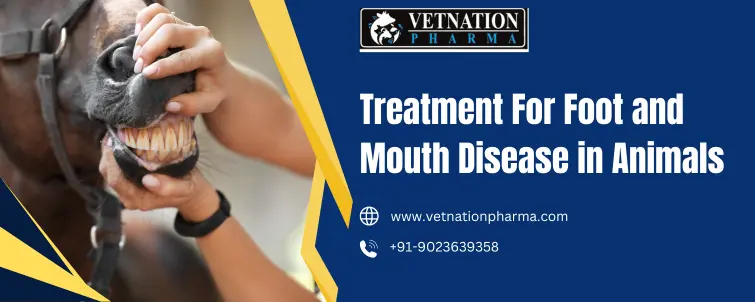- Veterinary PCD & Third Party Manufacturing
- +91-9023639358
- vetnationpharma@gmail.com
Treatment For Foot and Mouth Disease in Animals
Treatment For Foot and Mouth Disease in Animals : Vetnation Pharma
Foot and mouth disease (FMD) is a severe, highly contagious viral disease that affects cloven-hoofed animals such as cattle, pigs, sheep, goats, and deer. The disease is caused by the FMD virus, which comes in seven different serotypes, making it a complex challenge for control and eradication. Early detection and prompt treatment are crucial in managing FMD outbreaks. Treatment for foot and mouth disease in animals typically involves supportive care to alleviate symptoms, such as providing soft feed, ensuring adequate hydration, and administering pain relief. Additionally, controlling the spread through quarantine measures, vaccination, and culling of infected and at-risk animals is essential in managing the disease effectively.
Symptoms of Foot and Mouth Disease
Would you like to add more details about the symptoms or treatment for Foot and Mouth Disease in animals?
- Fever
- Blisters on the tongue, lips, and between the hooves
- Lameness
- Drooling
- Loss of appetite
- Weight loss
Immediate Steps to Take When FMD is Suspected
If you suspect an animal is infected with FMD, immediate action is necessary to prevent the spread:
- Isolate the Infected Animals: Quickly separate infected animals from healthy ones to prevent the virus from spreading.
- Notify Authorities: Report the outbreak to veterinary authorities to initiate a coordinated response.
- Restrict Movement: Implement movement restrictions on animals, personnel, and equipment.
Effective Treatments for Foot and Mouth Disease
While there’s no cure for foot and mouth disease, several Treatment For Foot and Mouth Disease in Animals can help manage the symptoms and prevent secondary infections.
1. Supportive Care
Supportive care is essential in helping animals recover from FMD. This includes:
- Hydration: Ensuring animals have access to clean water to prevent dehydration.
- Nutrition: Providing a balanced diet to support immune function and recovery.
- Pain Management: Administering pain relief medications to reduce discomfort and improve mobility.
2. Antibiotics
Although antibiotics do not treat the FMD virus itself, they are useful in preventing secondary bacterial infections, which can complicate recovery. Veterinarians may prescribe antibiotics to keep infections at bay.
3. Vaccination
Vaccination is a critical tool in the fight against FMD. In regions where the disease is endemic, regular vaccination programs help build immunity in livestock populations. Key points include:
- Emergency Vaccination: During an outbreak, emergency vaccination can help contain the spread.
- Routine Vaccination: In areas prone to FMD, routine vaccinations are essential for prevention.
Preventative Measures
Preventing foot and mouth disease is far better than dealing with an outbreak. Here are some effective preventative measures. Additionally, ensuring proper treatment for foot and mouth disease in animals is crucial if an outbreak does occur.
1. Biosecurity Measures
Implementing strict biosecurity measures can significantly reduce the risk of FMD:
- Disinfection: Regularly disinfect vehicles, equipment, and facilities.
- Quarantine: Isolate new or returning animals for a period before introducing them to the main herd.
- Protective Clothing: Use protective clothing and footwear for farm workers to minimize the risk of virus transmission.
2. Monitoring and Surveillance
Constant monitoring and surveillance are vital for early detection and control of FMD:
- Regular Health Checks: Conduct regular health checks to catch any signs of FMD early.
- Diagnostic Testing: Utilize diagnostic tests to confirm FMD cases and assess the spread.
3. Public Awareness and Training
Educating farmers, veterinarians, and the public about FMD is crucial for prevention:
- Training Programs: Provide training on recognizing symptoms and implementing biosecurity measures.
- Information Campaigns: Run information campaigns to raise awareness about FMD and its impact.

Conclusion
Foot and mouth disease in animals poses a significant threat to livestock industries worldwide. While there’s no cure, effective treatments and preventative measures can help manage and control the disease. By understanding the symptoms, implementing supportive care, utilizing antibiotics for secondary infections, and prioritizing vaccination, farmers and veterinarians can protect animal health and minimize the impact of FMD. Treatment for foot and mouth disease in animals involves supportive care to manage symptoms, preventing secondary infections with antibiotics, and using vaccines to control outbreaks.
Contact Information
Contact Vetnation Pharma if you want to know Treatment For Foot and Mouth Disease in Animals or any other part of PAN India.
- Write us: vetnationpharma@gmail.com
- Company Name: Vetnation Pharma
- Company Address: Plot no 295, Industrial area phase -2, Panchkula- 134 109, Haryana (India)
- Contact us: +91- 90236 39358
- Website: www.vetnationpharma.com/
FAQ :
- Q: What is the first step in Treatment For Foot and Mouth Disease in Animals?
A: The first step is to isolate the infected animals to prevent the spread of the disease to other livestock. - Q: Are there any medications available for Treatment For Foot and Mouth Disease in Animals?
A: There are no specific antiviral medications for Foot and Mouth Disease. Treatment focuses on supportive care, such as pain relief and maintaining hydration. - Q: How can supportive care help animals with Foot and Mouth Disease?
A: Supportive care includes providing soft feed, ensuring adequate water intake, and treating secondary infections to help animals recover. - Q: Is vaccination an effective measure for Foot and Mouth Disease in animals?
A: Yes, vaccination is an effective preventive measure and can help control outbreaks of Foot and Mouth Disease in livestock populations.
